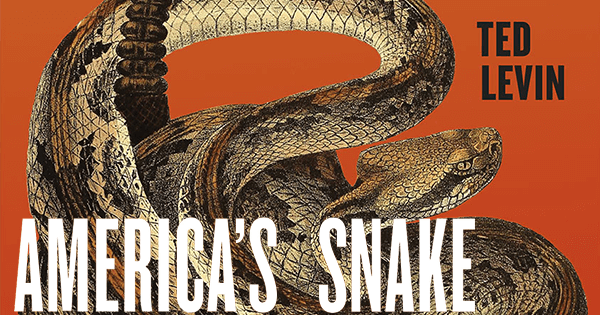America’s Snake
An excerpt from Ted Levin’s new book about the rise and fall of the rattlesnake

Who isn’t scared of snakes? Our primate cousins avoid them as viscerally as we do, and researchers have even identified a part of the human brain that evolved to help us identify snakes more quickly.
Timber rattlers, as they’re known colloquially, are found in 31 states and on the outskirts many major metropolitan areas. Even so, few of us have ever encountered one, and even fewer have read much about them. Ted Levin’s new book, America’s Snake: The Rise and Fall of the Timber Rattlesnake, locates his quarry in all its habitats—myth, history, research labs, and the backyards of amateur herpetologists—and places our slithering reptile neighbors at the center of the struggle to preserve the natural world from human encroachment.
Read an excerpt on how Levin’s love affair with the timber rattler began, when he was a curious kid on the shores of Long Island.
The thing between timber rattle snakes and me started in the late fifties. Although there used to be colonies from Brooklyn to Sag Harbor, by the end of World War II the only Long Island rattle snakes were hanging as trophies in old farmhouses or submerged in specimen jars, their glassy eyes dulled by formalin. The last record of a Long Island rattle snake came from the pine barrens of East Moriches in 1962, the year after my bar mitzvah. According to a 1915 article in Copeia, the journal of the American Society of Ichthyologists and Herpetologists, the rapid decline of the island’s rattle snakes closely followed the eastward extension of the Long Island Railroad in 1895. The snakes adopted the fatal habit of sunning themselves on railroad embankments and lounging on the heated rails. As a kid, I laid pennies on those same tracks, under those same wheels, perhaps, innocent of the fate of these prior denizens.
There were other snakes in my neighborhood, all quotidian—garter snakes, ribbon snakes, northern water snakes, little brown snakes, milk snakes, black racers, even theatrical hognose snakes—every one of them cool in their own right, but certainly without the aura of a husky rattle snake, dark as night or sulfur yellow and longer than I was tall. That timber rattle snakes see in the dark through pits in their face and have rattle-tipped tails that send out a loud, monotonous insect-like buzz when they are afraid or annoyed, quickening one’s senses, as would a gunshot in the woods, adds to the allure. And, of course, there’s the venom. …
Wherever Long Island rattle snakes passed the winter, they were long gone before I ever knew they were there. To see one, I’d go to the Staten Island Zoo. Carl Kauffeld, curator of reptiles and later director, had transformed the small zoo into a rattle snake emporium. Kauffeld exhibited the finest rattle snake collection in the world, all thirty-two species and subspecies occurring within the United States. I saw my first timber rattler there, a dark-phased adult collected in the mountains north of New York City. The snake was shedding (ecdysis, biologists call it), and I stood by the glass-fronted cage as it crawled out of its skin, one, long serpentine sleeve peeling back, inch by inch, inside out, like taking off a sock.
Reprinted with permission from America’s Snake: The Rise and Fall of the Timber Rattlesnake, by Ted Levin. Published by the University of Chicago Press. © 2016 The University of Chicago. All rights reserved.

